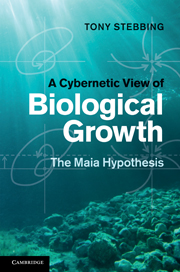Book contents
- Frontmatter
- Contents
- Foreword by Ernest Naylor
- Preface: ‘A fragment of a possible world’
- Acknowledgements
- 1 Introduction
- 2 Growth unlimited: blooms, swarms and plagues
- 3 Self-regulating systems: from machines to humans
- 4 The wealth of homeodynamic responses
- 5 A cybernetic approach to growth analysis
- 6 A control mechanism for Maia
- 7 The three levels of adaptation
- 8 Population growth and its control
- 9 Hierarchy: a controlled harmony
- 10 History of hormesis and links to homeopathy
- 11 Maian mechanisms for hormesis and catch-up growth
- 12 Cellular growth control and cancer
- 13 Human overpopulation
- 14 Our finite Earth
- 15 The Maia hypothesis and anagenesis
- Glossary
- Further reading
- References
- Index
11 - Maian mechanisms for hormesis and catch-up growth
Published online by Cambridge University Press: 10 January 2011
- Frontmatter
- Contents
- Foreword by Ernest Naylor
- Preface: ‘A fragment of a possible world’
- Acknowledgements
- 1 Introduction
- 2 Growth unlimited: blooms, swarms and plagues
- 3 Self-regulating systems: from machines to humans
- 4 The wealth of homeodynamic responses
- 5 A cybernetic approach to growth analysis
- 6 A control mechanism for Maia
- 7 The three levels of adaptation
- 8 Population growth and its control
- 9 Hierarchy: a controlled harmony
- 10 History of hormesis and links to homeopathy
- 11 Maian mechanisms for hormesis and catch-up growth
- 12 Cellular growth control and cancer
- 13 Human overpopulation
- 14 Our finite Earth
- 15 The Maia hypothesis and anagenesis
- Glossary
- Further reading
- References
- Index
Summary
What is hormesis and why haven't we heard about it before?
Leonard Sagan (1985)The hormetic model is not an exception to the rule – it is the rule.
Calabrese and Baldwin (2003)HORMESIS IN RECENT TIMES
The first meeting on radiation hormesis was held in California in August 1985. Although I had not worked on radiation hormesis, I had published a review a few years earlier, which included examples of radiation hormesis. This was an attempt to put over the idea that hormesis was a general phenomenon that I believed would be shown to have a general explanation. So I had deliberately included in the review examples of hormesis that were as diverse as could be found. They encompassed a wide range, including different toxic agents and organisms from many phyla, some showing the hormetic effects of radiation. The examples chosen were all of growth hormesis, because that was my interest, although the reader should appreciate that hormesis occurs in a number of other biological processes as well, from the fields of biochemistry, physiology, behaviour and others. The examples of growth hormesis from the literature had been published in many different forms, so in my review they were plotted in the same way, showing that they matched the β-curve. Even the examples exhibiting radiation hormesis ranged from bacteria and protozoans to insects and guinea pigs, although the majority were due to low levels of other toxic agents of the form characterised by the β-curve (Figure 10.1).
- Type
- Chapter
- Information
- A Cybernetic View of Biological GrowthThe Maia Hypothesis, pp. 266 - 291Publisher: Cambridge University PressPrint publication year: 2010



